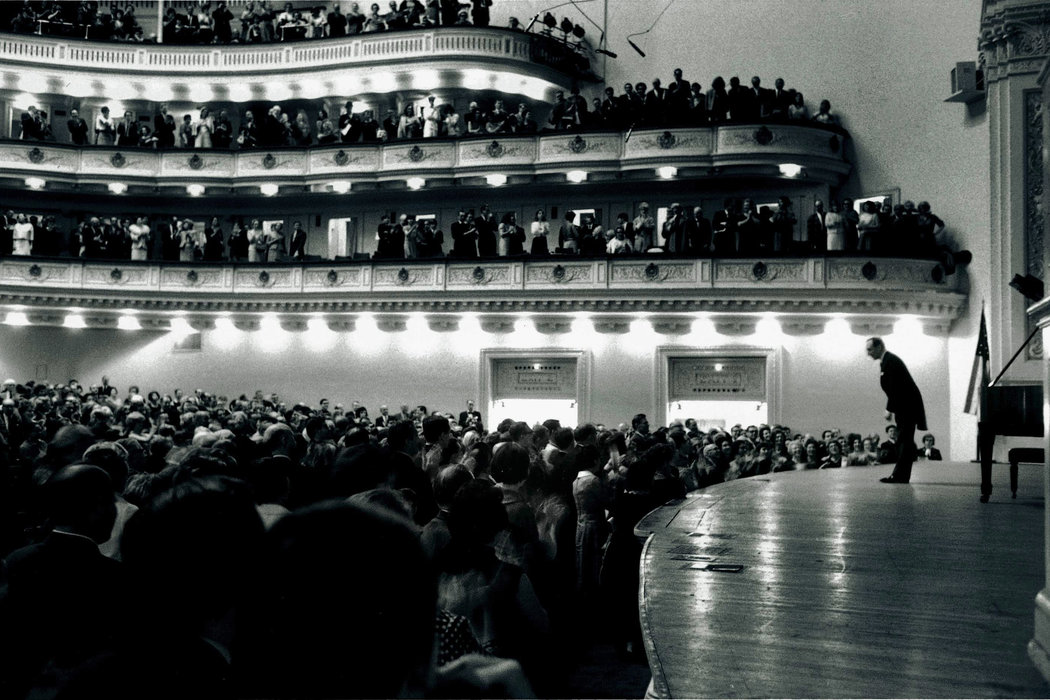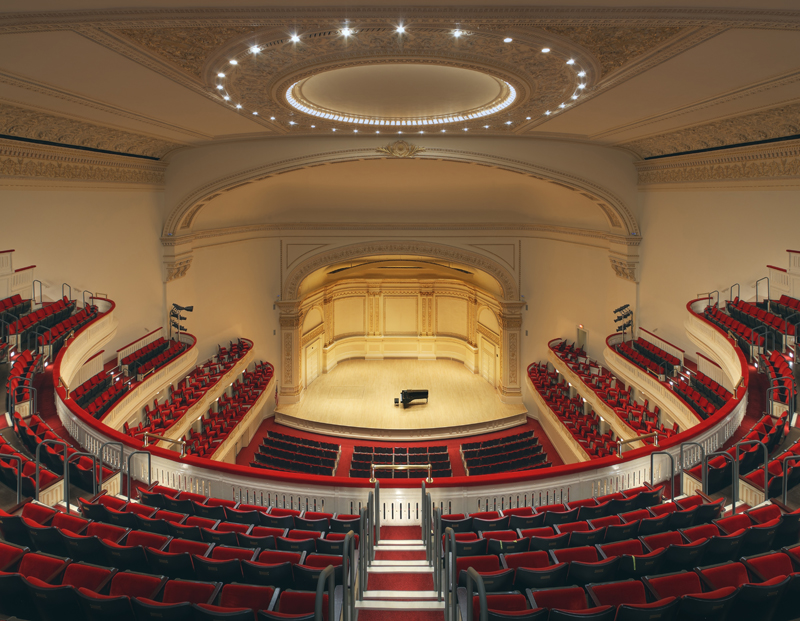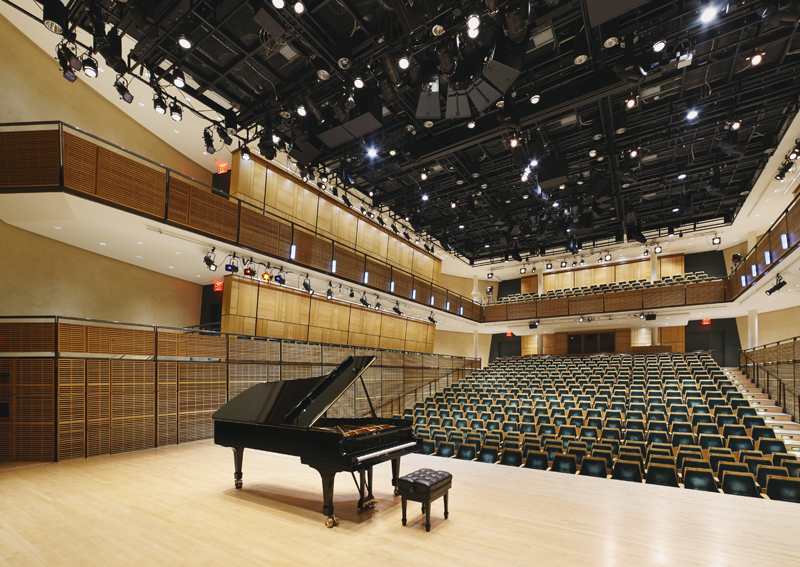
VENUES: CARNEGIE HALL
Article by Michael Refvem (MGBH)
Since its opening night, blessed by performance of Peter Ilyich Chaikovsky (OBM), Carnegie Hall in Manhattan, New York has been one, if not the most, of the world’s prestigious classical performance venues. Such pianists as Vladimir Horowitz (OBM), Sergei Rachmaninoff (OBM), and Arthur Rubinstein (OBM) played an important part in contributing to the grandeur of this place. Many books have been written about the famous Carnegie Hall and events that happened there over the years. In this article, we would like to review the history of this amazing venue, give tribute to its founder, and reveal a few secrets.

And here [are] 2,700 odd people who had been sitting for an hour…waiting. And suddenly the house lights go out and the stage lights go on and PHYSICALLY, backstage, it felt like putting one’s hand in an electric socket. And I brought him downstairs and to the edge of the stage and he turned around and faced me. [He] said “I’m looking at you,” and I thought ‘what do I do now? … Oh! Ok!’ So I turned him around and put my hand in the lower part of his back and pushed him out onto the stage. Well… the wave, the sheer sound wave of all those people getting up and greeting him was physical. You really were just physically hit by it… and then he gestured to the piano and started to sit down, and the silence was just as loud as the applause had been a moment ago. – Schuyler Chapin (MDBH), The Art of Piano: Great Pianists of the 20th Century [1]
Such is the story of Vladimir Horowitz’ legendary return to the concert stage on May 9, 1965, after a 12 year sabbatical from public performance [2]. It is no surprise that this epic re-launch took place at Carnegie Hall, the most prestigious stage in the world. Few concert halls have lived up to the legacy and mystique of Carnegie Hall, a legacy built by the international stature of the great artists to perform there since its inception.

[…] in the 1890’s, New York City’s midtown was centered around 14th to 20th streets – Carnegie Hall (established in 1891 as “The Music Hall”) sat between suburbs and farmland.
Today the neighborhood surrounding Carnegie Hall is one of Manhattan’s most exclusive. But in the 1890’s, New York City’s midtown was centered around 14th to 20th streets – Carnegie Hall (established in 1891 as “The Music Hall”) sat between suburbs and farmland [3]. And while the hall has been named after Andrew Carnegie (OBM) since 1893 [4], it may be more appropriate to refer to it as Mrs. Carnegie’s (OBM) hall. It’s believed that Carnegie, then a newlywed, built the music hall as a wedding gift to his wife, Louise Whitfeld Carnegie, says Gino Francesconi (MGBH), director of Carnegie Hall archives. [5]

Carnegie Hall opened with a five day music festival featuring composer Pyotr Illyich Tchaikovsky (OBM) conducting several of his works including the first Piano Concerto. Carnegie Hall has seen thousands of performances throughout its history including notable premieres such as Antonín Dvořák’s (OBM) Symphony No. 9 (“From the New World) (1893), Gustav Mahler’s (OBM) Symphony No. 2 (“Resurrection”) (1908) and George Gershwin’s (OBM) Concerto in F (1925). The hall has also been no stranger to popular music since 1938, when Benny Goodman (OBM) and his Orchestra made their debut. The Beatles also famously performed two concerts at Carnegie Hall in 1964. [6]
William Tuthill (OBM) was the chief architect of the hall, and his design decisions reflect the tastes of the day. The building is in the Italian Renaissance revival style with simple masonry arches integral to stability (before the days of structural steel), but also features an Edwardian sensibility with its gold leaf patterns and red velvet upholstery on the seats. Sadly, these aesthetics lost their charm decades later. And in the mid-1950’s when the hall was looking for new ownership, it was slated for demolition. Carnegie Hall had been offered for sale to the New York Philharmonic, but the symphony already had plans to relocate to Lincoln Center, which was being constructed nearby. Under pressure, a group led by violinist Isaac Stern (OBM) famously saved Carnegie Hall from the wrecking ball. [7]

When most people talk about Carnegie Hall, they are usually referring to the Stern (OBM) Auditorium dedicated in honor of the great violinist in 1997 (2,804 seats) [8]. The accompanying recital spaces, Zankel (OBM) Recital Hall (599 seats) and Weill (OBM) Recital Hall (268 seats) are no less elegant. Zankel Recital Hall opened in 2003, after being converted from being a cinema and features cutting edge design that can be reconfigured to several different arrangements [9].

Weill Recital Hall, the smallest of the three halls, is where several emerging concert artists make important debuts to the international music community and has been in use continuously since 1891 [10].

Unless you’ve gotten a bird’s eye view of Carnegie Hall, you probably didn’t know about the new rooftop garden terrace. It was added during the recent Studio Towers Renovation Project along with the Resnick Education Wing, all of which opened in the fall of 2014. The remodel provides space to host receptions before and after concerts as well as foster the developing talents of New York City music students. [11]

Acoustically speaking, Carnegie Hall’s Stern Auditorium is well known for it’s seemingly miraculous properties, but after a renovation in 1986, concert-goers swore that the sound was a bit off.
Acoustically speaking, Carnegie Hall’s Stern Auditorium is well known for it’s seemingly miraculous properties, but after a renovation in 1986, concert-goers swore that the sound was a bit off. And they were right! The culprit? A slab of concrete found underneath the stage nearly a decade later. “They opened the stage floor, found the cement, took it away and the sound came back,” said Francesconi. [12] Having seen a number of performances there myself, I can attest to the hall’s unique ability to accommodate performances of all types. Perfect for an entire symphony orchestra, the hall is equally suited for an intimate solo recital or chamber music setting.
[…] after a renovation in 1986, concert-goers swore that the sound was a bit off. And they were right! The culprit? A slab of concrete found underneath the stage nearly a decade later.
Looking back, it seems inconceivable to think that Carnegie Hall was ever at risk of being lost forever, but thanks to its designation as a National Historic Landmark in 1964 and New York City Landmark in 1967, this fabled venue will continue to present some of the world’s greatest musicians for generations to come. [13]
References:
[1] Sturrock, Donald (1999). The Art of Piano: Great Pianists of the 20th Century (Documentary). Quote by Schulyer Chapin dictated by the author. Start at 26 minutes and 13 seconds. https://youtu.be/vpiMAaPTze8?t=26m13s
[2] Schultz, Rick (January 04, 2007) Vladimir Horowitz at Carnegie Hall: What the fuss was all about. The Los Angeles Times. Retrieved December 16, 2016. http://articles.latimes.com/2014/jan/04/entertainment/la-et-cm-vladimir-horowitz-carnegie-hall-20140105
[3] 1893 The Music Hall becomes Carnegie Hall. The Carnegie Hall Corporation. Retrieved December 16, 2016. https://www.carnegiehall.org/History/Notable-Events/
[4] Spencer, Luke (June 09, 2015). The Most Incredible Parts of Carnegie Hall Are Offstage. Atlas Obscura. Retrieved December 16, 2016. http://www.atlasobscura.com/articles/carnegie-hall
[5] ibid 4, History of the Hall. Retrieved December 16, 2016. https://www.carnegiehall.org/History/Timeline/Timeline.aspx?id=4294968566
[6] Conry, Tara (April 27, 2015). Secrets of Carnegie Hall. AM New York. Retrieved December 16, 2016.
http://www.amny.com/secrets-of-new-york/carnegie-hall-secrets-1.10233196
[7] The New York Preservation Archive Project. http://www.nypap.org/wp-content/uploads/2016/04/carnegie-hall-1895.jpg
[8] ibid 6
[9] ibid 4, Isaac Stern and the Saving of the Hall. Retrieved December 16, 2016. https://www.carnegiehall.org/Article.aspx?id=4294967976
[10] REF: ibid 4, Joan and Sanford I. Weill Hall. Retrieved December 16, 2016. https://www.carnegiehall.org/Information/Weill-Recital-Hall/
[11] REF: ibid 4, Judith and Burton Resnick Education Wing. Retrieved December 16, 2016. https://www.carnegiehall.org/resnick/
[12] REF: ibid 7
[13] REF: ibid 10
About the Author:
Michael Refvem enjoys a multifaceted career as recitalist, chamber musician and concerto soloist. He recently moved to Montréal, where he enjoys walks in the old town and Mount Royal in his spare time.
 Piano Performer Magazine
Piano Performer Magazine 






